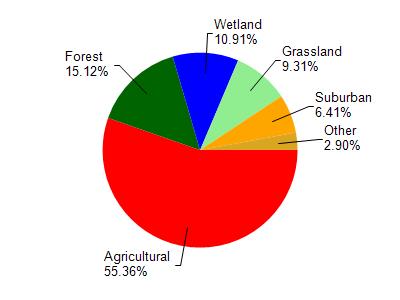Walworth
No
No
No
Fish and Aquatic Life
Overview
Green Lake, in the Sugar and Honey Creeks Watershed, is a 282.67 acre lake that falls in Walworth County. This lake is managed for fishing and swimming and is currently not considered impaired.
Date 2011
Author Aquatic Biologist
Historical Description
Managed for largemouth bass, panfish, walleye and northernpike. Prior to impoundment (10' dam) this was a series of 3 major basins or
"kettle holes". Impoundment created much the same problems that accompanied this practice on Beulah Lake; weeds in shallow, previously
dry bays and a highly irregular shore line with much shore dwelling space and little surface acreage for recreation there are over 14 miles of
shoreline, or only 57.7 acres of water per mile of frontage. Access is provided by town roads; however, there is a fee for parking and all roads
are posted against parking. Boats may be rented from 3 liveries. Nearly all developable frontage has dwellings, and recently, land developers
have undertaken construction of an artificial lagoon with access to the lake. Approximately 170 acres of wetland lie contiguous with the shallow
bays of Middle and Mill Lakes. Source: 1961, Surface Water Resources of Walworth County,WI: WI-DNR Lauderdale Lakes, T-4-N, R-16-E, Surface Acres = 809, S.D.F. = 3.54, Maximum Depth = 57 feet,(Encompasses Green, Middle, Mill Lakes.)
Date 1961
Author Surface Water Inventory Of Wisconsin
General Condition
Green Lake (755800) was assessed during the 2016 listing cycle; total phosphorus and chlorophyll sample data were clearly below 2016 WisCALM listing thresholds for the Recreation use and Fish and Aquatic Life use. This water is meeting these designated uses and is not considered impaired.
Date 2015
Author Ashley Beranek
Condition
Wisconsin has over 84,000 miles of streams, 15,000 lakes and milllions of acres of wetlands. Assessing the condition of this vast amount of water is challenging. The state's water monitoring program uses a media-based, cross-program approach to analyze water condition. An updated monitoring strategy (2015-2020) is now available. Compliance with Clean Water Act fishable, swimmable standards are located in the Executive Summary of Water Condition in 2018. See also the 'monitoring and projects' tab.
Reports
Recommendations
Habitat Restoration - Shoreland
Walworth County will continue the Walworth County Lakes Specialist position for one year. The Lakes Specialist will provide educational information to lake residents regarding shoreline stabilization and shoreline restoration. The Lakes Specialist will also design shoreline restoration projects for interested landowners, provide technical assistance to contractors and hold workshops on shoreland restoration.
Protect Riparian or Shorelands
Walworth County will implement the Shoreland Protection Initiative project that includes: 1. A baseline lakeshore inventory; 2. ten lakshore demonstration sites; 3. the preparation of lake lawn and yard nutrient management plans; 4. fact sheets on lakeshore stabilization, shoreland buffers, shoreland regulations and lawn care; 5. an annual lakeshore inventory and distribution of shoreland regulation materials; 6. formation of a Walworth Co. Lakes Association and meetings with and newsletter pertaining to Walworth Co. lakes; 7. Workshops, information packets and news articles pertaining to the Fox river Basin Partnership Team Lakes Initiative; and 8. the formation of the Walworth County Land Conservancy.
Management Goals
Wisconsin's Water Quality Standards provide qualitative and quantitative goals for waters that are protective of Fishable, Swimmable conditions [Learn more]. Waters that do not meet water quality standards are considered impaired and restoration actions are planned and carried out until the water is once again fishable and swimmable
Management goals can include creation or implementation of a Total Maximum Daily Load analysis, a Nine Key Element Plan, or other restoration work, education and outreach and more. If specific recommendations exist for this water, they will be displayed below online.
Monitoring
Monitoring the condition of a river, stream, or lake includes gathering physical, chemical, biological, and habitat data. Comprehensive studies often gather all these parameters in great detail, while lighter assessment events will involve sampling physical, chemical and biological data such as macroinvertebrates. Aquatic macroinvertebrates and fish communities integrate watershed or catchment condition, providing great insight into overall ecosystem health. Chemical and habitat parameters tell researchers more about human induced problems including contaminated runoff, point source dischargers, or habitat issues that foster or limit the potential of aquatic communities to thrive in a given area. Wisconsin's Water Monitoring Strategy was recenty updated.
Grants and Management Projects
Monitoring Projects
| WBIC | Official Waterbody Name | Station ID | Station Name | Earliest Fieldwork Date | Latest Fieldwork Date | View Station | View Data |
|---|
| 755800 | Green Lake | 10006670 | Green Lake | 6/1/1990 | 3/31/2025 | Map | Data |
| 755800 | Green Lake | 10017637 | Green Lake -- Lauderdale Lakes | 8/29/2003 | 9/13/2025 | Map | Data |
| 755800 | Green Lake | 653123 | Green Lake - Deepest Point | 9/18/1973 | 8/21/2025 | Map | Data |
|

Watershed Characteristics
Green Lake is located in the Sugar and Honey Creeks watershed which is 166.22 mi². Land use in the watershed is primarily agricultural (55.30%), forest (15.10%) and a mix of wetland (10.90%) and other uses (18.60%). This watershed has 208.62 stream miles, 1,943.12 lake acres and 9,489.18 wetland acres.
Nonpoint Source Characteristics
This watershed is ranked High for runoff impacts on streams, Medium for runoff impacts on lakes and High for runoff impacts on groundwater and therefore has an overall rank of High. This value can be used in ranking the watershed or individual waterbodies for grant funding under state and county programs.This water is ranked High Lake for individual Lakes based on runoff problems and the likelihood of success from project implementation.